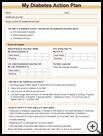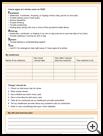
Diabetes: Ketoacidosis
________________________________________________________________________
KEY POINTS
- Diabetic ketoacidosis (DKA) is a buildup of acids in the blood that can cause coma or death if not treated right away.
- DKA is a medical emergency and needs to be treated right away at a hospital. You will be given insulin, other medicine, and IV fluids.
- Check your blood sugar level to keep it under control, as recommended by your healthcare provider. Ask your provider when you should check for ketones.
________________________________________________________________________
What is diabetic ketoacidosis?
Diabetic ketoacidosis (DKA) is a buildup of acids in the blood. If your body does not make enough insulin, sugar cannot move out of your blood and into your cells. Your blood sugar can get very high and your body burns fat instead of sugar for energy. This makes byproducts called ketones. When ketones build up to dangerous levels, it is called ketoacidosis. This can cause coma or death if not treated right away. Ketoacidosis may happen with type 1 diabetes. It rarely happens with type 2 diabetes.
What is the cause?
DKA can happen if you skip doses of insulin. Or it may happen if there is a change in your health, such as:
- Infection
- Injury
- Heart attack
- Surgery
- Pregnancy
- Other types of physical or emotional stress
If you are using an insulin pump, it may happen if you stop getting insulin because the pump is not working or there is a kink in the tube or the tube comes out.
What are the symptoms?
Symptoms of ketoacidosis may include:
- Shortness of breath
- Fruity smelling breath
- Very dry mouth
- Abdominal pain, nausea, or vomiting
Symptoms of high blood sugar may include:
- Blurry vision
- Dry mouth
- Feeling very thirsty and drinking a lot
- Urinating a lot
- Feeling tired all the time
- Confusion or a hard time paying attention
If the pancreas stops making insulin, blood sugar can get very high and ketones can build up to a high level very fast. It may happen so fast that ketoacidosis symptoms may be the first symptoms that you have before you have even been diagnosed with diabetes.
Several hours to a couple of days after symptoms start, ketoacidosis may cause a coma.
How is it diagnosed?
Your healthcare provider will ask about your symptoms and medical history and examine you. You will have blood and urine tests.
How is it treated?
DKA is a life-threatening medical emergency and needs to be treated right away at a hospital. You will be given insulin, other medicines, and IV fluids. With early treatment, you will usually recover in hours to days.
How can I take care of myself and help prevent DKA?
- Keep your blood sugar level under control, as recommended by your healthcare provider.
- Check your blood sugar level as often as you and your provider have discussed. Give yourself additional insulin for high blood sugar as directed by your provider.
- Never take more insulin than your regular dose unless you have double checked your blood sugar reading and made sure that your sugar level is too high and you need more insulin.
- Watch for the early signs and symptoms of ketoacidosis.
- Ask your healthcare provider when you should check for ketones. Your provider may recommend checking for ketones if:
- Your blood sugar level is higher than recommended by your healthcare provider (usually around 240 mg/dL.)
- You are ill or under more stress than usual. When you are sick, ketones can be present even if your blood sugar is not high.
Let your provider know right away if there are ketones in your urine or blood.
- Keep extra insulin with you.
- Do not exercise when your blood sugar levels are high and you have ketones in your urine.
- Carry a medical ID (such as a card or bracelet) that says you have diabetes.
Ask your provider:
- How and when you will get your test results
- How long it will take to recover
- If there are activities you should avoid and when you can return to your normal activities
- How to take care of yourself at home
- What symptoms or problems you should watch for and what to do if you have them
Make sure you know when you should come back for a checkup. Keep all appointments for provider visits or tests.


